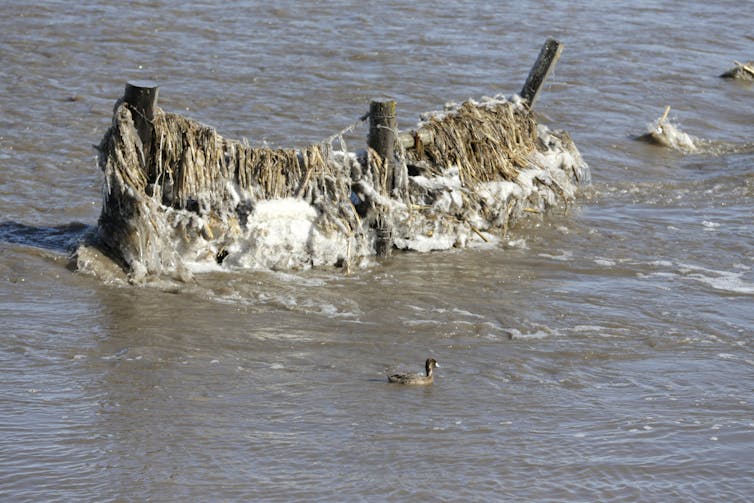The dirt on soil loss from the Midwest floods
- Written by Jim Ippolito, Associate Professor of Environmental Soil Quality/Health, Colorado State University
As devastating images of the 2019 Midwest floods fade from view, an insidious and longer-term problem is emerging across its vast plains: The loss of topsoil that much of the nation’s food supply relies on.
Today, Midwest farmers are facing millions of bushels of damaged crops such as soybean and corn. This spring’s heavy rains have already caused record flooding[1], which could continue into May and June, and some government officials have said it could take farmers years to recover[2].
Long after the rains stop, floodwaters continue to impact soil’s physical, chemical and biological properties that all plants rely on for proper growth. Just as very wet soils would prevent a homeowner from tending his or her garden, large amounts of rainfall prevent farmers from entering a wet field with machinery. Flooding can also drain nutrients out of the soil that are necessary for plant growth as well as reduce oxygen needed for plant roots to breathe, and gather water and nutrients[3].
As scientists who have a combined 80 years of experience studying soil processes, we see clearly that many long-term problems farmers face from floodwaters are steeped in the soil. This leads us to conclude that farmers may need to take far more active measures to manage soil health in the future as weather changes occur more drastically due to climate change and other factors.
Here are some of the perils with flooded farmland that can affect the nation’s food supply.
Suffocating soil
When soil is saturated by excessive flooding, soil pores are completely filled with water[4] and have little to no oxygen present. Much like humans, plants need oxygen to survive, with the gas taken into plants via leaves and roots. Also identical to humans, plants – such as farm crops – can’t breathe underwater.
 A fence encrusted with ice and cornstalks stands in Nebraska floodwaters.
AP Photo/Nati Harnik[5]
A fence encrusted with ice and cornstalks stands in Nebraska floodwaters.
AP Photo/Nati Harnik[5]
Essentially, excess and prolonged flooding kills plant roots because they can’t breathe[6]. Dead plant roots in turn lead to death of aboveground plant, or crop, growth.
Another impact of flooding is compacted soil. This often occurs when heavy machinery is run over wet or saturated farmland. When soils become compacted, future root growth and oxygen supply are limited. Thus, severe flooding can delay or even prevent planting for the entire growing season, causing significant financial loss to farmers[7].
Loss of soil nutrients
When flooding events occur, such as overwatering your garden or as with the 2019 Midwest flooding, excess water can flush nutrients out of the soil. This happens by water running offsite, leaching into and draining through the ground, or even through the conversion of nutrients from a form that plants can utilize to a gaseous form that is lost from the soil to the atmosphere.
Regardless of whether you are a backyard gardener or large-scale farmer, these conditions can lead to delays in crop planting, reduced crop yields, lower nutritive value in crops and increased costs in terms of extra fertilizers used. There is also the increased stress within the farming community – or for you, the backyard gardener who couldn’t plant over the weekend due to excess rainfall. This ultimately increases the risk of not producing ample food over time.
Small microbial changes have big effects
Flooding on grand scales causes soils to become water-saturated for longer than normal periods of time. This, in turn, affects soil microorganisms that are beneficial for nutrient cycling.
Flooded soils may encounter problems caused by the loss of a specific soil microorganism, arbuscular mycorrhizae fungi. These fungi colonize root systems in about 90% to 95% of all plants on Earth in a mutually beneficial relationship.
The fungi receive energy in the form of carbon from the plant. As the fungi extend thread-like tendrils[8] into the soil to scavenge for nutrients, they create a zone where nutrients can be taken up more easily by the plant. This, in turn, benefits nutrient uptake and nutritive value of crops.
When microbial activity is interrupted, nutrients don’t ebb and flow within soils in the way that is needed for proper crop growth. Crops grown in previously flooded fields may be affected due to the absence of a microbial community that is essential for maintaining proper plant growth.
The current Midwest flooding has far-reaching effects on soil health that may last many years. Recovering from these types of extreme events will likely require active management of soil to counteract the negative long-term effects of flooding. This may include the adoption of conservation systems that include the use of cover crops, no-till or reduced-till systems, and the use of perennials grasses, to name few. These types of systems may allow for better soil drainage and thus lessen flooding severity in soils.
Farmers have the ability to perform these management practices, but only if they can afford to convert over to these new systems; not all farmers are that fortunate. Until improvements in management practices are resolved, future flooding will likely continue to leave large numbers of Midwest fields vulnerable to producing lower crop yields or no crop at all.
References
- ^ caused record flooding (www.duluthnewstribune.com)
- ^ years to recover (www.foxbusiness.com)
- ^ plant roots to breathe, and gather water and nutrients (www.hort.vt.edu)
- ^ completely filled with water (www.floodsite.net)
- ^ AP Photo/Nati Harnik (www.apimages.com)
- ^ they can’t breathe (www.scienceabc.com)
- ^ causing significant financial loss to farmers (www.drovers.com)
- ^ fungi extend thread-like tendrils (www.westernsydney.edu.au)
Authors: Jim Ippolito, Associate Professor of Environmental Soil Quality/Health, Colorado State University
Read more http://theconversation.com/the-dirt-on-soil-loss-from-the-midwest-floods-114423

